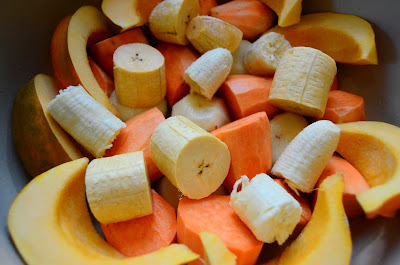Often, when I start planning our weekly international menu, I search "National dish of ___" as a starting point. When I found out that the national dish of Peru was ceviche, a spicy raw fish dish, "cooked" only by marinating a bit in lime juice, I was skeptical. Surely, we could find something more accessible to the kids. The more I looked, the more I realized ceviche was actually probably our best option. It certainly would be easier to procure and prepare than guinea pig.
So, after reading about the safety of raw fish, I followed the recipe and then let it marinate a good hour. As dinner approached, I tentatively tried a bite... and found the chewy texture singularly unappealing. Maybe I tried the wrong kind of fish. Maybe I'm just a midwestern girl with an unsophisticated palate. I do, for example, greatly prefer Korean kimbap to Japanese sushi - largely because kimbap doesn't involve any raw fish.
Anyway, when Collin walked in the door, he echoed my concern. So I threw the whole bowl into a hot skillet for a minute or two, and cooked it just until the fish started to taste flakier than chewier. That flash in the pan made a huge difference, even if it softened the vegetables a little more than was desirable.
I served the ceviche in cups made from corn tortillas, baked in a muffin tin. I just sprayed the muffin tin with oil, pushed in a warm corn tortilla (or two halves, since mine were largely broken), sprayed them with oil again and baked them about 10 minutes. They weren't perfect, but they made an otherwise not-so-kid-friendly dish fun to eat. We had roasted sweet potatoes on the side, as well as popcorn.
Popcorn? As a side? Well, yes.
A common accompaniment to ceviche is toasted corn kernels called cancha. From what I gather, it's kind of like corn nuts, and kind of like the popcorn kernels that fail to pop. I didn't have the right kind of corn, but I did have this beautiful Indian flint corn I grew last summer. It pops, but leaves a lot of partially-popped kernels in the bottom. So, I popped a big bowl of half rainbow corn, half conventional popcorn, and separated out puffy from the crunchy kernels. The rainbow corn tastes a lot better toasted than conventional popcorn, but I'm sure the texture is still pretty different than Peruvian cancha.
So, in the end, we had both kinds of popcorn for dinner, and it was a fun, if unusual, side dish.
Toward the end of the meal, Jenny pulled the whole bowl of popcorn over to her place, and ate handful after handful. Popcorn for dinner was just fine with her!
For dessert, I made arroz con leche, or rice pudding. I followed this recipe, except I used a can of evaporated milk for part of the milk, and then filled the measuring cup the rest of the way with whole milk. One cup of dry rice makes quite a large pot of rice pudding, and I might have made a half batch if I'd known how large it would end up.
Collin loves rice pudding, and it's one of those things he's always asking me to make and I never make enough to satisfy him. So, before digging in, he had to take a moment to inhale the sweet smell of milky rice topped with cinnamon and cloves.
After that, he shared a bite with Eliza. She quickly realized it was THE BEST THING SHE HAD EVER TASTED. Then it was all Collin could do to get a mouthful in between sharing with Eliza, and keeping her hands out of the bowl at the same time.
She does look pretty adorable with a rice pudding mustache.





















































